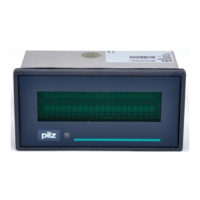
Do you have a question about the Pilz PX 30 and is the answer not in the manual?
| Product type | Touch terminal |
|---|---|
| Operating System | Windows Embedded Compact 7 |
| Power Supply | 24 V DC |
| Protection type | IP65 (front) |
| Touch Technology | Resistive |
| Processor | ARM Cortex-A8 |
| RAM | 512 MB |
| Connectivity | Ethernet, USB, RS232 |
| Protection Class | IP65 (front) |
| Operating Temperature | 0°C to +50°C |
| Storage Temperature | -20°C to +70°C |
| Display | TFT |
Essential precautions for electrical connections and operating conditions.
Guidelines for display installation, wiring, and heat dissipation.
Overview of how the PX 30/PX 120 units function and their modes.
Key features of the PX 30 and PX 120 units, including display format.
Details on handshake, display modes, and parallel/serial drive methods.
Explains serial communication protocols and operating modes for PX units.
Describes the Flash-EPROM capacity and address range for text storage.
Information on software for text creation and character sets.
Lists and explains commands for display control like clear display, flashing.
How to display additional lines of text using scroll inputs.
Details on the number and length of variables available per text.
Formatting options for variables like justification and leading zeros.
Using inputs to create flashing cursors or question marks for prompts.
Settings for binary or BCD data transmission.
Configuration for 24 or 16-input mode on PX 120.
How to set the address for networking text displays.
Specifications like operating voltage, power consumption, and interfaces.
Pinout details for the V24 serial interface connection.
Physical dimensions for PX 30 and PX 120 text displays.
List of error codes and their meanings for troubleshooting.
How to connect multiple PX displays in a network.
Wiring diagrams for connecting the V24 interface.
